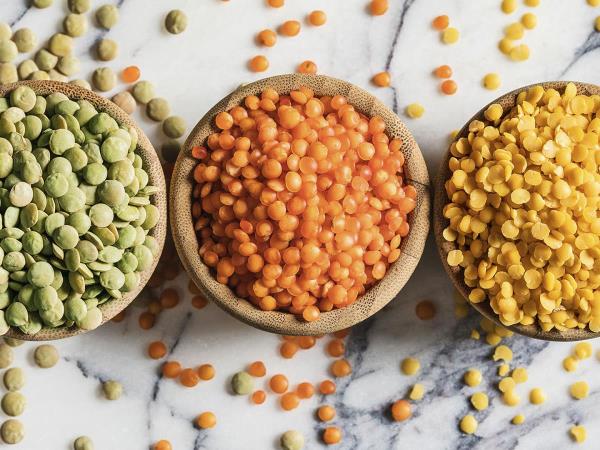Old friend from Egypt and India
Lentils have been used around the world for over 9000 years. The first records of lentils can be found in ancient India and Egypt, where they were grown and consumed daily. The Romans believed that lentils heal the soul and body, the Greeks even considered them a symbol of modesty and prudence. Lentils are still a staple food in India today, where they are used to prepare the famous dish dal, which is a warm, nutritious, and spiced dish with added turmeric, known for its natural anti-inflammatory properties.
Why is lentil still so beneficial today?
Lentils are special because in their tiny grains, they hide exceptional nutritional power. In 100 grams of raw lentils, you can find:
- 9 grams of protein, more than in an egg,
- 8 grams of dietary fiber, which promote a healthy digestive system,
- high content of folic acid (more than 45% of daily needs),
- rich source of iron, magnesium, zinc, B vitamins (especially B1 and B6).
These nutrients are essential for the functioning of our brains, heart, nerves, and digestive system. It's no wonder that lentils are considered superfoods, with exceptional nutritional value in small quantities.
Lentils against sugar: natural ally for diabetics
Official data show that diabetes currently affects more than 537 million people worldwide (data from the International Diabetes Federation, 2021) and is becoming one of the biggest health problems of modern times. One of the main reasons for its occurrence is an unhealthy diet – too many processed carbohydrates, too much sugar, and insufficient fiber intake.
Lentils, however, despite containing carbohydrates, do not cause a spike in blood sugar. Why?
The reason lies in their structure. Lentils have starch trapped in a dense network of dietary fibers. These fibers act as natural digestion inhibitors, slowing down how quickly the starch converts into glucose, blood sugar. This means that after a lentil meal, the sugar in the blood rises slowly, which is ideal for those struggling with insulin or wanting to avoid the so-called sugar crash after a meal.
A Canadian study from 2018, published in the journal Clinical Nutrition, showed that participants who consumed lentils instead of white rice or potatoes had up to 35% lower post-meal glucose levels.
Additionally, lentils also contain resistant starch (scientifically: amylose), which the body breaks down slowly because enzymes cannot attack all its sites at once, as it happens with starch with branched chains (scientifically: amylopectin).
Lentils and cholesterol: how do fibers help?
Science today agrees: dietary fibers lower cholesterol levels. Lentils excel in this area. They contain a special type of fiber – beta-glucan, which has the ability to bind bile acids in the intestines (made from cholesterol) and helps eliminate them from the body.
When the body loses these bile acids, it needs to make new ones – and therefore, it utilizes cholesterol from the blood. This naturally lowers cholesterol levels, without the need for pills and without side effects.
A study from 2016 (British Journal of Nutrition) showed that just 100 grams of lentils per day for one month can reduce total cholesterol by 12% and LDL (bad) cholesterol by over 8%.
Gut health and lentils
A healthy gut is the foundation of a strong immune system and well-being. Lentils contain dietary fibers that serve as food for good bacteria in our intestines – these bacteria produce short-chain fatty acids that have anti-inflammatory effects, protect the intestinal wall, and even influence our mood.
You might be surprised, but today, the gut is also considered our second brain, as over 90% of serotonin, the happiness hormone, is produced there.
Lentils in everyday cooking
Lentils have a mild, slightly nutty flavor that pairs well with both meat and vegetables. They especially go well with rice, tomatoes, onions, garlic, and herbs such as marjoram, bay leaf, oregano, and parsley.
For those with little time, here's good news: red and yellow lentils do not require soaking and cook in just 15-20 minutes. Green and brown lentils, on the other hand, take a bit more time but have a firmer texture and are excellent for stews.
For example: a cup of cooked lentils (200g) has only 230 calories but keeps you satisfied for hours. It has more protein than an egg, more fiber than two whole wheat bread rolls, and more iron than a piece of beef.
Recipe for lentils with rice
This dish has been prepared since ancient times when simple ingredients needed to be turned into something tasty and nutritious. Today, we make it because we know it's also very healthy.
You'll need:
- 130g lentils (green or brown),
- 70g whole-grain rice,
- 200g ripe tomatoes (or peeled tomatoes),
- 1 medium onion,
- 1 clove of garlic,
- 1 tablespoon of olive oil,
- salt, pepper, bay leaf, marjoram, oregano, and chili to taste
Preparation:
Soak the lentils overnight (if they are not red or yellow). Then rinse them and cook with a little salt. Meanwhile, saut{-15447} the onion and garlic in olive oil, add chopped tomatoes, spices, and then add lentils and rice. Add about a liter of water or vegetable broth and cook until the rice is soft. Serve the dish warm, sprinkled with fresh parsley.
Optionally, you can add turmeric or curry, which have additional anti-inflammatory effects.
Why not cook lentils today?
In the flood of expensive superfoods coming from other continents, lentils are modest, local, and inexpensive. A kilogram of lentils costs less than 3 euros, and its effects on the body include:
- lower blood sugar levels,
- lower cholesterol levels,
- more energy, and
- a stronger gut
And another thing: lentils are also environmentally friendly. Producing a kilogram of lentils requires 10 times less water than producing the same amount of beef and results in fewer greenhouse gases.










 Would you like to be informed about news on the website?
Would you like to be informed about news on the website?

